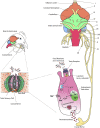The avian taste system
- PMID: 37745254
- PMCID: PMC10516129
- DOI: 10.3389/fphys.2023.1235377
The avian taste system
Abstract
Taste or gustation is the sense evolving from the chemo-sensory system present in the oral cavity of avian species, which evolved to evaluate the nutritional value of foods by detecting relevant compounds including amino acids and peptides, carbohydrates, lipids, calcium, salts, and toxic or anti-nutritional compounds. In birds compared to mammals, due to the relatively low retention time of food in the oral cavity, the lack of taste papillae in the tongue, and an extremely limited secretion of saliva, the relevance of the avian taste system has been historically undermined. However, in recent years, novel data has emerged, facilitated partially by the advent of the genomic era, evidencing that the taste system is as crucial to avian species as is to mammals. Despite many similarities, there are also fundamental differences between avian and mammalian taste systems in terms of anatomy, distribution of taste buds, and the nature and molecular structure of taste receptors. Generally, birds have smaller oral cavities and a lower number of taste buds compared to mammals, and their distribution in the oral cavity appears to follow the swallowing pattern of foods. In addition, differences between bird species in the size, structure and distribution of taste buds seem to be associated with diet type and other ecological adaptations. Birds also seem to have a smaller repertoire of bitter taste receptors (T2Rs) and lack some taste receptors such as the T1R2 involved in sweet taste perception. This has opened new areas of research focusing on taste perception mechanisms independent of GPCR taste receptors and the discovery of evolutionary shifts in the molecular function of taste receptors adapting to ecological niches in birds. For example, recent discoveries have shown that the amino acid taste receptor dimer T1R1-T1R3 have mutated to sense simple sugars in almost half of the living bird species, or SGLT1 has been proposed as a part of a T1R2-independent sweet taste sensing in chicken. The aim of this review is to present the scientific data known to date related to the avian taste system across species and its impact on dietary choices including domestic and wild species.
Keywords: avian species; diet; gustatory system; preference; taste receptors.
Copyright © 2023 Niknafs, Navarro, Schneider and Roura.
Conflict of interest statement
The authors declare that the research was conducted in the absence of any commercial or financial relationships that could be construed as a potential conflict of interest.
Figures



References
-
- Abumandour M. M. A., El-Bakary N. E. R. (2017). Morphological features of the tongue and laryngeal entrance in two predatory birds with similar feeding preferences: common kestrel (Falco tinnunculus) and hume’s tawny owl (Strix butleri). Anat. Sci. Int. 92, 352–363. 10.1007/s12565-016-0339-9 - DOI - PubMed
-
- Alagawany M., Elnesr S. S., Farag M. R., Tiwari R., Yatoo M. I., Karthik K., et al. (2020). Nutritional significance of amino acids, vitamins and minerals as nutraceuticals in poultry production and health - a comprehensive review. Vet. Q. 41, 1–29. 10.1080/01652176.2020.1857887 - DOI - PMC - PubMed
-
- Bath W. (1906). Die Geschmacksorgane der vogel und krokodile. Arch. fur Biontologie 1, 5–47.
Publication types
LinkOut - more resources
Full Text Sources

